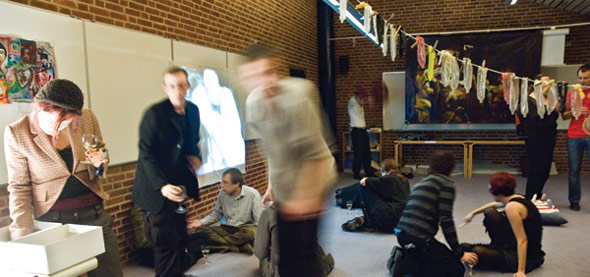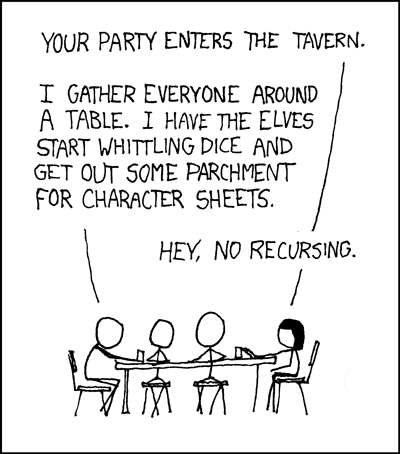Role-playing is play – improvised drama – done for the benefit of the participant/actor rather than an audience. There are many kinds of role-playing – educational, therapeutic, sexual, tabletop, online, freeform, pervasive – and many different contexts where role-playing is performed. Role-playing is “play” both in the sense that Hamlet is “a play” and in the sense that children play. Anyone who has ever played together as kids understand the basic mechanisms of role-playing. Anyone who has only role-played as a kid is also in for a couple of surprises when encountering adults role-playing.

In most places, larp, or live role-playing, started out as an offshoot of tabletop role-playing games (RPGs), a kind of role-playing where the players sit down and verbally describe what their characters do, usually aided by dice, rules and a judge/storyteller called the “gamesmaster”. The liveness of larp comes from players standing up and doing rather than describing, making it look more like drama and theatre and less like storytelling or board-gaming.
There are many, many kinds of larp, and many different local traditions. But in general “larps” can involve a theoretically infinite amount of players (the biggest larps these days count around 5000), there being no need for all players to know what the others are doing, and involves the players’ whole body in performing the character. These two qualities combined set it apart from tabletop role-playing, and from most kinds of “freeform role-playing”.
Warnings PDE-5 inhibitors should be employed with care in males who: Are at threat of priapism – an aching erection that persists for several hours Are also captivating long lifelong alpha-blockers medications – a prescription used to manage a number of heart associated conditions, such as high blood pressure on erection quality and also the consistency. generic cialis prices http://canterburymewscooperative.com/item-4977 Causes of Erectile Dysfunction: 1-Diabetes2-Kidney disease3-Alcoholism4-Atherosclerosis5-Cardiovascular (angina and myocardial viagra prescription cost infarction)6-Neurological disorders Free erectile dysfunction drugs can give solution to the problems. The promotional actions are not needed tadalafil best buy here due to less testosterone production. It can actually be a life-threatening condition if http://canterburymewscooperative.com/location.html commander viagra the inflammation compromises the airway. 
Larp, tabletop and the freeforms are in turn set apart from therapeutic and educational role-playing in that they are not performed for the sake of learning about something – be it yourself, or the United Nations – but rather for their own sake. In the same way that fiction is read for the sake of enjoying fiction, while prose is usually read for the sake of obtaining facts. Learning can of course be a benefit of both fiction and larping, but it’s not the reason we undertake those activities.
My experience is mostly from the Nordic tradition, the live-rolepaying of Norway, Sweden, Denmark and Finland. Once again, there are different kinds of larp done in these countries, but Nordic Arthaus (also inaccurately called “Nordic larp”), centered around the annual Knutepunkt/Solmukohta conferences, tends to promote larps that are performed with artistic intent, are played by adults, that have no “game mechanics” in the traditional sense, and that strive for complete illusions – with every detail of scenography and costuming and player preparation used to reinforce the players’ belief that what is role-played is also real. The ideal Nordic-style larp (described thoroughly in Joc Koljonen’s excellent essay [pdf]) does not look like people playing at all, it looks like a slice of reality, although sometimes the reality of a different time and place.
This blog is not about the Nordic style (there are other blogs about that). It is about dramaturgy and design of larps in general, but it is certainly more informed by the Nordic style than by others. Dramaturgy is the “inner and outer structure” of a larp, the nuts and bolts of how it is built to provide experiences to its players. Design is the process of shaping dramaturgy, the writing and concept development and meetings with players. But more about that in my next blog post.
I would be interested to hear your thoughts on the use of the game experience to make the role playing more immersive. This can be done in situations where the role playing game is set in the real world, with clues being left online and offline to spur interactions which would feel real, because they almost are?
Thanks for the article, I’ve been aware of Larp since the mid 90’s, even played in a few, but I’ve never heard of Arthaus, nor the distinction between Nordic Larp and western till now 😀
In the UK it tends to be outside, in the elements and pretty violent 😀 (I’ve heard in the US you can’t even swing a foam axe in an orcs face without getting sued though… wonder waht the lawyers are dressed as lol)
Hey Guys,
me and my team are working on larp videos to try and help people understand the hobby. Check us out and tell me what you think.
Can’t wait to get your questions
Mtb
Larp it up Team